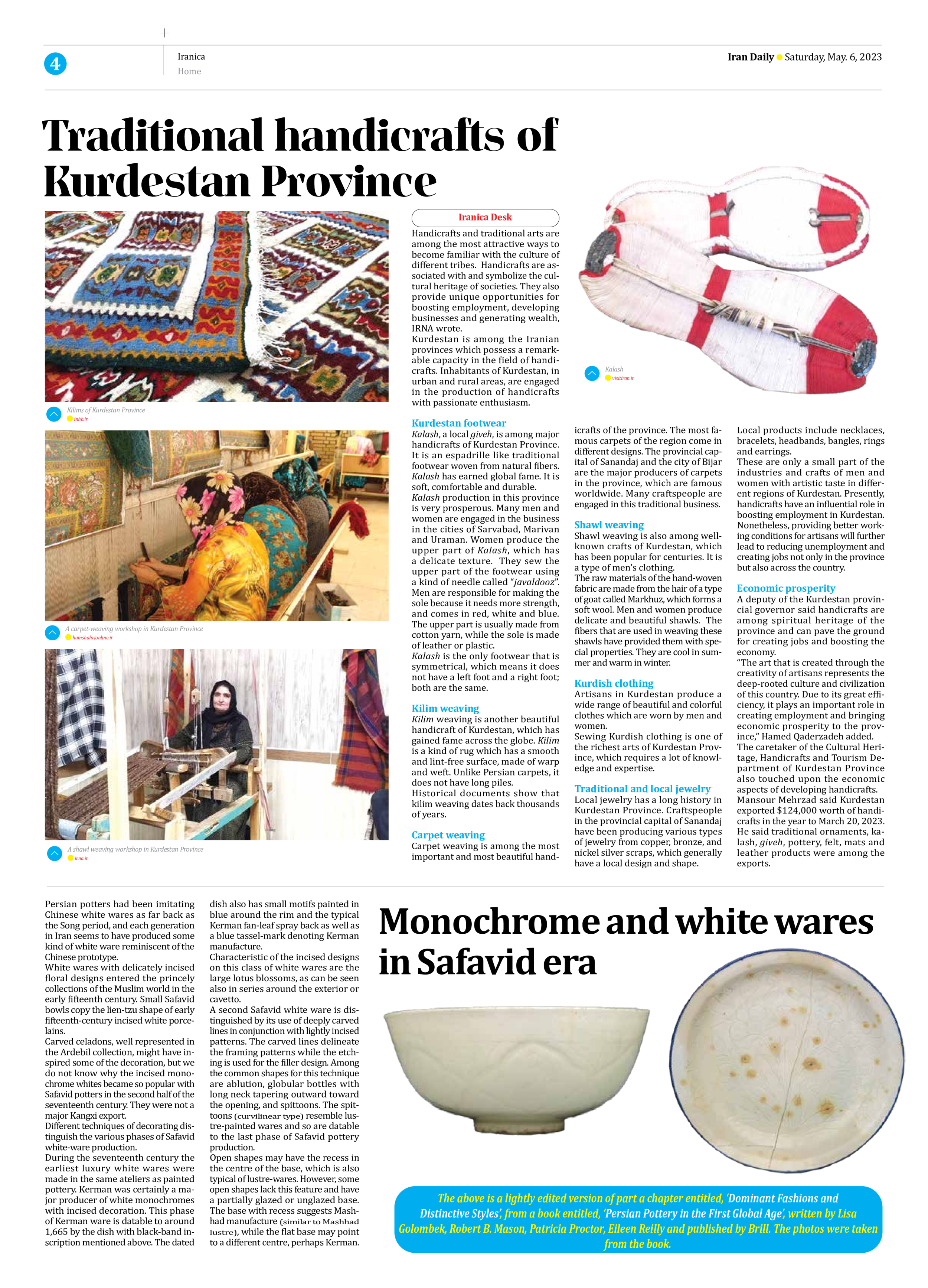
Traditional handicrafts of Kurdestan Province
Handicrafts and traditional arts are among the most attractive ways to become familiar with the culture of different tribes. Handicrafts are associated with and symbolize the cultural heritage of societies. They also provide unique opportunities for boosting employment, developing businesses and generating wealth, IRNA wrote.
Kurdestan is among the Iranian provinces which possess a remarkable capacity in the field of handicrafts. Inhabitants of Kurdestan, in urban and rural areas, are engaged in the production of handicrafts with passionate enthusiasm.
Kurdestan footwear
Kalash, a local giveh, is among major handicrafts of Kurdestan Province. It is an espadrille like traditional footwear woven from natural fibers. Kalash has earned global fame. It is soft, comfortable and durable.
Kalash production in this province is very prosperous. Many men and women are engaged in the business in the cities of Sarvabad, Marivan and Uraman. Women produce the upper part of Kalash, which has a delicate texture. They sew the upper part of the footwear using a kind of needle called “javaldooz”. Men are responsible for making the sole because it needs more strength, and comes in red, white and blue. The upper part is usually made from cotton yarn, while the sole is made of leather or plastic.
Kalash is the only footwear that is symmetrical, which means it does not have a left foot and a right foot; both are the same.
Kilim weaving
Kilim weaving is another beautiful handicraft of Kurdestan, which has gained fame across the globe. Kilim is a kind of rug which has a smooth and lint-free surface, made of warp and weft. Unlike Persian carpets, it does not have long piles.
Historical documents show that kilim weaving dates back thousands of years.
Carpet weaving
Carpet weaving is among the most important and most beautiful handicrafts of the province. The most famous carpets of the region come in different designs. The provincial capital of Sanandaj and the city of Bijar are the major producers of carpets in the province, which are famous worldwide. Many craftspeople are engaged in this traditional business.
Shawl weaving
Shawl weaving is also among well-known crafts of Kurdestan, which has been popular for centuries. It is a type of men’s clothing.
The raw materials of the hand-woven fabric are made from the hair of a type of goat called Markhuz, which forms a soft wool. Men and women produce delicate and beautiful shawls. The fibers that are used in weaving these shawls have provided them with special properties. They are cool in summer and warm in winter.
Kurdish clothing
Artisans in Kurdestan produce a wide range of beautiful and colorful clothes which are worn by men and women.
Sewing Kurdish clothing is one of the richest arts of Kurdestan Province, which requires a lot of knowledge and expertise.
Traditional and local jewelry
Local jewelry has a long history in Kurdestan Province. Craftspeople in the provincial capital of Sanandaj have been producing various types of jewelry from copper, bronze, and nickel silver scraps, which generally have a local design and shape.
Local products include necklaces, bracelets, headbands, bangles, rings and earrings.
These are only a small part of the industries and crafts of men and women with artistic taste in different regions of Kurdestan. Presently, handicrafts have an influential role in boosting employment in Kurdestan. Nonetheless, providing better working conditions for artisans will further lead to reducing unemployment and creating jobs not only in the province but also across the country.
Economic prosperity
A deputy of the Kurdestan provincial governor said handicrafts are among spiritual heritage of the province and can pave the ground for creating jobs and boosting the economy.
“The art that is created through the creativity of artisans represents the deep-rooted culture and civilization of this country. Due to its great efficiency, it plays an important role in creating employment and bringing economic prosperity to the province,” Hamed Qaderzadeh added.
The caretaker of the Cultural Heritage, Handicrafts and Tourism Department of Kurdestan Province also touched upon the economic aspects of developing handicrafts.
Mansour Mehrzad said Kurdestan exported $124,000 worth of handicrafts in the year to March 20, 2023.
He said traditional ornaments, kalash, giveh, pottery, felt, mats and leather products were among the exports.







